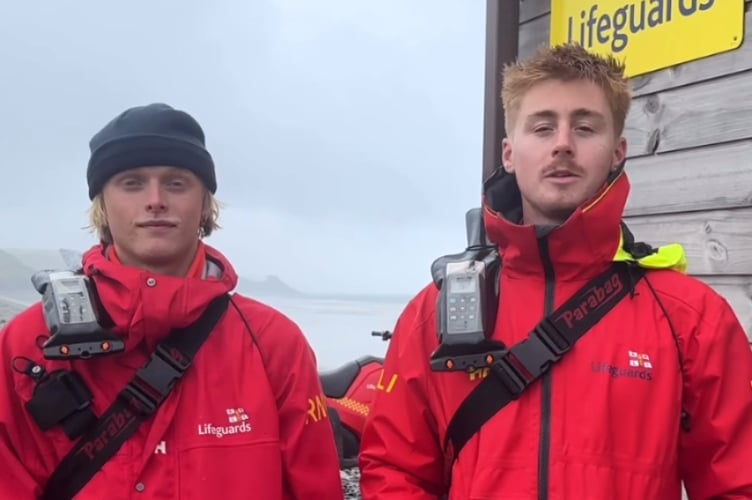RNLI share important advice to Pembrokeshire’s beach-goers and sea swimmers on World Drowning Prevention Day.
World Drowning Prevention Day is a global event that is held annually on July 25 to remember lives lost due to drowning and to increase knowledge on safety in and around water.
Pembrokeshire’s RNLI beach lifeguards were on hand this week to rescue multiple people at Newgale beach on July 23, when lifeguards patrolling raced into action to rescue six people and assisted a further eight people from rip currents and flash rip currents!
The combination of 1-2ft surf and the sandbanks at low tide caused an abundance of rip currents to form. RNLI lifeguards were kept busy providing preventative advise to the public and encouraging them to swim between the red and yellow flags.
Senior Lifeguard George Morgan said: “In total we rescued six people and assisted a further eight, but also gave out preventative advice to hundreds of people.
“The combination of surf, wind, and tide moving across the sandbanks at Newgale often creates flash rip currents. The location of these currents can change every day and are impossible to predict. This forces us to regularly move the flags and dynamically assess the beach.
“We strongly advise that you swim and bodyboard between the red and yellow flags or surf, kayak and paddleboard between the black and white flags. The flagged areas are patrolled at all times by our lifeguards between 10am-6pm.
“If you see the red flag flying, we have deemed that area of the beach as unsafe, most commonly due to rip currents.”
Not long after midday, at the north end of Newgale Beach, a flash rip current appeared.
Two bodyboarders were rescued and three surfers were assisted out of the rip current by Lifeguard Jake Rogers.
Shortly after, another two bodyboarders were stuck in a rip current and struggling to return to shore.
Once again, Jake made his way to them on a rescue board and assisted them back to shore.
The Rescue Water Craft (RWC) was launched to guide people to stay within the correct flagged areas.
Lifeguard George Morgan was operating the RWC and spotted two bodyboarders floating out to sea. He immediately made his way towards them as they realised they were in trouble and were waving for assistance.
George assisted one of the casualties onto the RWC sled and Lifeguard Travis Christopher-Mullins had made his way out on a rescue board and helped the second casualty onto his board. Both casualties were returned safely to shore.

Shortly after, Lifeguard Jake was patrolling on the RWC and came across a surfer in a rip current. He assisted the surfer and ensured he could safely return to the beach. Once back on patrol, Jake spotted another two swimmers who were struggling in a rip current. He helped them onto the rescue sled and returned them to shore.
Just before the end of the lifeguards’ shift, Lifeguard Cai Owen spotted two bodyboarders who were a long way out of their depth. The bodyboarders were in a rip current, so Cai made his way out to them on a rescue board and assisted them back to shore.
Stuart Penfold, Lead Lifeguard Supervisor for North Pembrokeshire said:
“If you find yourself caught in a rip current, don’t swim against it or you’ll get exhausted. If you can stand, then wade don’t swim. If you can, try to swim parallel to the shore until you’re free of the current, and then head back to shore. Always raise your hand and shout for help.
“If you’re ever unsure as to why we’ve red flagged the beach, please approach our lifeguards. We’re more than happy to offer guidance and direct you to a safer place to swim.
“In Pembrokeshire the following beaches are currently being patrolled every day from 10am-6pm: Newport Sands, Poppit Sands, Whitesands, Newgale Central and South, Broad Haven, Freshwater West, Tenby North, Tenby Castle, Tenby South and Saundersfoot.
“Choose one of our lifeguarded beaches if you’re planning a dip.”
As cold water swimming has become more and more popular over the years, the outdoor experts at Blacks have explained the benefits of cold water swimming and also offered their safety tips to anyone who wants to get into the sport this year.
Vicky McCreadie, cold-water swimming coach at Wonderful Wild Women said: “Cold-water swimming has long been suspected of multiple health benefits and now the science and studies are there to back this up. Cold water stimulates a natural response from your body; releasing chemicals into the body inclusive of dopamine, serotonin and cortisol.”
Ethan Ball, Author and outdoor enthusiast at Blacks commented: “If you’re considering cold water swimming, there are a few important factors to remember to ensure you stay safe and get the most from your wild swim.
“One main consideration is that when entering cold water with a temperature below 15°C and you're not accustomed to it, your body may react with an involuntary gasp.
“This is often followed by hyperventilation, which is not within your conscious control. If you've jumped or dived in, or if the water is turbulent, water can enter your lungs, leading to rapid drowning. To help mitigate this risk, follow our top tips on how to swim in cold water safely.”



